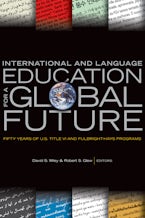The contributions to this book address the role that the U.S. Department of Education Title VI and Fulbright-Hays programs have played in building the largest and highest quality infrastructure in the world for training in languages and other aspects of foreign area knowledge. The volume celebrates the 50th anniversary of the Title VI and associated Fulbright-Hays programs, which have established more than 150 centers of excellence for modern foreign language and area studies and international business education in more than 60 U.S. universities.
The authors review the history of the programs, including their founding and their cumulative impacts on internationalizing the American university at the graduate and undergraduate levels. They review how programs for foreign research, technology for foreign information access, and undergraduate programs have built the foundations of U.S. language-learning materials for use in college courses and government with improved language-learning pedagogies, erected the most distinguished library holdings on foreign countries, supported in-depth research abroad in virtually every nation, and created capacity to teach more than 200 less commonly taught languages.
ContentsAcknowledgments1. Introduction: Seeking Global Competence through the Title VI and Fulbright-Hays ActsPART 1. THE ROLE OF TITLE VI PROGRAMS IN NATIONAL AND GLOBAL SECURITY2. Gulliver’s Travels: The History and Consequences of Title VI3. Title VI and National and Global Security: Current Status and Concerns Going ForwardPART 2. TITLE VI PROGRAMS AND THE LESS COMMONLY TAUGHT LANGUAGES4. The Impact of Fifty Years of Title VI on Language Learning in the United States5. The Growth of the Less Commonly Taught Languages in Title VI and Language Programs in the United States6. Language Competence—Performance, Proficiency, and Certification: Current Status and New DirectionsPART 3. THE HISTORY AND SIGNIFICANCE OF THE PROGRAMS OF TITLE VI HIGHER EDUCATION ACT7. Title VI and Foundation Support for Area Studies: Its History and Impacts8. The Changing Form and Function of Title VI since Its Beginnings in the 1960s9. The Impact of Title VI Programs on the U.S. Higher Education System0: Lessons from the First Thirty Years (1958–1988)PART 4. INTERNATIONALIZING HIGHER EDUCATION AND TITLE VI PROGRAMS10. Area Studies and Academic Disciplines across Universities: A Relational Analysis with Organizational and Public Implications11. Renewing International Studies: Regional and Transregional Studies in a Changing Intellectual FieldPart 5. GLOBAL COMPETITIVENESS12. Title VI and Global Competitiveness: Building International Business Education for the Twenty-First Century13. Title VI and the Global Competitiveness of U.S. FirmsPART 6. ACCESSING, BENCHMARKING, AND ASSESSING TITLE VI14. Beyond Accountability: A Balanced Approach to Assessment and Benchmarking15. Accessing and Assessing Title VI International Education Programs:The View from Black CollegesPART 7. FUTURE DIRECTIONS FOR TITLE VI AND FULBRIGHT-HAYS PROGRAMS16. Preparing for the Future: Title VI and Its Challenges17. Future Directions for Title VI and Fulbright-Hays Programs: Creativity and Competence for Facing Global ChallengesA. Title VI and Fulbright-Hays Programs of the U.S. Department of EducationB. U.S. Department of Education Title VI National Resource Centers, Language Resource Centers, Centers for International Business Education, American Overseas Resource Centers, and the Institute for International Public Policy, 2006–2010C. Summary of Discussions from Plenary Panels, Title VI 50th Anniversary ConferenceD. Papers Presented at the Title VI 50th Anniversary Conference, March 19–21, 2009, Washington, D.C.E. Less Commonly Taught Languages Offered in the Title VI National Resource CentersAbout the ContributorsIndex

